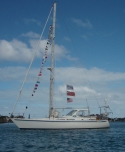We were warned in 2015 that there would be significant changes to the requirements for a clean hull for vessels arriving in NZ. This arose from the Mediteranean Fan worm issue that was causing problems in the Auckland area. Well the three years are up and the new requirements come into effect May15, 2018. There is a lot of information available from the Ministry - no fewer than 10 downloads in fact. The summary letter from Tracey Bates follows. I will discuss this in full later in the season on Gulf Harbour Radio. This is just to warn you that you will need to keep all records of cleaning, boat hull paint used, and make sure you start your passage home with a clean hull. Patricia Dallas. GHRadio
The following is a summary from MPI. (August 2018)
Compliance with the Craft Risk Management Standard for Biofouling (CRMS) will depend on the ability of a vessel operator to submit documentation that shows that one of the following has taken place:
• The vessel has been continually maintained using best practices
• The vessel has been cleaned less than 30 days prior to arrival
• The vessel is booked to be hauled out within 24 hours of arrival at an MPI-approved facility.
Most yachts visit New Zealand on “long-stay” itineraries, meaning they intend to remain in NZ for 21 days or more, and/or visit non-approved ports. Long-stay vessels are subject to stricter biofouling requirements due to the biosecurity risks associated with these itineraries, and must provide evidence they are clean of all fouling in excess of a slime layer and gooseneck barnacles.
Therefore, MPI encourages yachts to comply by cleaning within 30 days of arrival, or having a booking at an MPI-approved haul out facility. The skipper must have evidence (date-stamped photos of the hull and niche areas, haul out receipts, proof of booking, etc.) to show compliance when they arrive. MPI does not require the vessel to be hauled out to be cleaned prior to arrival-vessel owners are welcome to clean their own vessels, provided they follow all local regulations and carry documentation that all hull and niche areas have been thoroughly cleaned (such as date-stamped photos of the cleaned hull, and records in the vessel’s log book).
More information can be found in Appendix 2 and Appendix 3 of the Guidance Document for the CRMS: https://www.mpi.govt.nz/dmsdocument/11671-biofouling-on-vessels-arriving....
and the Frequently Asked Questions about the CRMS: https://www.mpi.govt.nz/dmsdocument/27444-craft-risk-management-standard...
MPI has also produced the following fact sheets for recreational vessels arriving into New Zealand:
• Recreational yachts: https://www.mpi.govt.nz/dmsdocument/28946-information-for-owners-and-ope...
• Superyachts: https://www.mpi.govt.nz/dmsdocument/21623-nz-biofouling-regulations-for-...
More guidance on how yachts can meet the requirements can be found on the cruising website noonsite.com: http://www.noonsite.com/Countries/NewZealand/new-zealand-new-biofouling-...
MPI has also updated the materials to be sent out in this year’s yacht packs to reflect the new requirements. The yacht packs can be found on the NZ Customs webpage (please note that this file has not been updated to include current MPI documents; however the physical yacht packs will contain updated guidance): https://www.customs.govt.nz/globalassets/documents/technical-lists-and-g...
If you would like advice about how to meet the biofouling requirements, please contact standards@mpi.govt.nz
